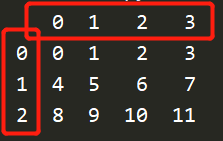Pandas 应用
Pandas 的主要数据结构是 Series (一维数据)与 DataFrame(二维数据),这两种数据结构足以处理金融、统计、社会科学、工程等领域里的大多数典型用例。
数据结构
Series 是一种类似于一维数组的对象,它由一组数据(各种Numpy数据类型)以及一组与之相关的数据标签(即索引)组成。
DataFrame 是一个表格型的数据结构,它含有一组有序的列,每列可以是不同的值类型(数值、字符串、布尔型值)。DataFrame 既有行索引也有列索引,它可以被看做由 Series 组成的字典(共同用一个索引)。
1、Pandas 数据结构 - Series
Series 带标签的一维数组
pandas.Series( data, index, dtype, name, copy)
参数说明:
- data:一组数据(ndarray 类型)。
- index:数据索引标签,如果不指定,默认从 0 开始。
- dtype:数据类型,默认会自己判断。
- name:设置名称。
- copy:拷贝数据,默认为 False。
如果没有指定索引,索引值就从 0 开始
t = pd.Series([4,5,6])
print(t)
print(type(t)) # <class 'pandas.core.series.Series'>
print(t[1]) # 5
"""
0 4
1 5
2 6
dtype: int64
<class 'pandas.core.series.Series'>
5
"""
指定索引值,修改数据类型:
t2 = pd.Series([2,4,6,8], index=list("abcd"))
print(t2)
print(t2["c"]) # 6
print(t2.astype(float))
print(t2[t2>5])
"""
a 2
b 4
c 6
d 8
dtype: int64
6
a 2.0
b 4.0
c 6.0
d 8.0
dtype: float64
c 6
d 8
dtype: int64
"""
使用 key/value 对象,类似字典来创建 Series
temp_dict = {"name": "wang1", "age": 18, "tel": 10010}t3 = pd.Series(temp_dict)
print(t3)
print(t3["age"]) # 18
print(t3[1]) # 18
print(t3[:2])
print(t3[[1,2]])
print(t3[["name","tel"]])
"""
name wang1
age 18
tel 10010
dtype: object
18
18
name wang1
age 18
dtype: object
age 18
tel 10010
dtype: object
name wang1
tel 10010
dtype: object
"""
获取 Series 的值、索引
print(t3.index) # Index(['name', 'age', 'tel'], dtype='object')
print(type(t3.index)) # <class 'pandas.core.indexes.base.Index'>print(t3.values) # ['wang1' 18 10010]
print(type(t3.values)) # <class 'numpy.ndarray'>
2、Pandas 数据结构 - DataFrame
DataFrame 是一个表格型的数据结构,它含有一组有序的列,每列可以是不同的值类型(数值、字符串、布尔型值)。DataFrame 既有行索引也有列索引,它可以被看做由 Series 组成的字典(共同用一个索引)

DataFrame 构造方法如下:
pandas.DataFrame( data, index, columns, dtype, copy)
DataFrame 二维,Series 容器
参数说明:
- data:一组数据(ndarray、series, map, lists, dict 等类型)。
- index:索引值,或者可以称为行标签。
- columns:列标签,默认为 RangeIndex (0, 1, 2, …, n) 。
- dtype:数据类型。
- copy:拷贝数据,默认为 False。
import pandas as pd
import numpy as np
t = pd.DataFrame(np.arange(12).reshape(3,4))
print(t)
"""0 1 2 3
0 0 1 2 3
1 4 5 6 7
2 8 9 10 11
"""

DataFrame对象既有行索引,又有列索引
行索引,表明不同行,横向索引,叫index,0轴,axis=0
列索引,表明不同列,纵向索引,叫columns,1轴,axis=1
2.1、index、columns 使用:
t1 = pd.DataFrame(np.arange(12).reshape(3,4), index=list("abc"), columns=list("wxyz"))
print(t1)
"""w x y z
a 0 1 2 3
b 4 5 6 7
c 8 9 10 11
"""
2.2、使用列表创建DataFrame,缺失的值用 NaN 代替
data = [['Google',10],['Runoob',12],['Wiki',13]]
df = pd.DataFrame(data,columns=['Site','Age'])
print(df)
"""Site Age
0 Google 10
1 Runoob 12
2 Wiki 13
"""
2.3、使用字典创建DataFrame,缺失的值用 NaN 代替
data = {'Site':['Google', 'Runoob', 'Wiki'], 'Age':[10, 12, 13]}
df = pd.DataFrame(data)
print (df)
"""Site Age
0 Google 10
1 Runoob 12
2 Wiki 13
"""
data = [{'a': 1, 'b': 2},{'a': 5, 'b': 10, 'c': 20}]
df = pd.DataFrame(data)
print (df)
"""a b c
0 1 2 NaN
1 5 10 20.0
"""
2.4、DataFrame基础属性
DataFrame.shape # 行数 列数
DataFrame.dtypes # 列数据类型
DataFrame.ndim # 数据维度
DataFrame.index # 行索引
DataFrame.columns # 列索引
DataFrame.values # 对象值DataFrame.head(3) # 显示头部几行,默认5行
DataFrame.tail(3) # 显示末尾几行,默认5行
DataFrame.info() # 相关信息概览:行数,列数,列索引,列非空值个数,列类型,内存占用
DataFrame.describe() # 快速综合统计结果:计数,均值,标准差,最大值,四分位数,最小值
data = [{'a': 1, 'b': 2},{'a': 5, 'b': 10, 'c': 20}]
df = pd.DataFrame(data)
print(df)
"""a b c
0 1 2 NaN
1 5 10 20.0
"""
print(df.index) # RangeIndex(start=0, stop=2, step=1)
print(df.columns) # Index(['a', 'b', 'c'], dtype='object')
print(df.values) # [[ 1. 2. nan] [ 5. 10. 20.]]
print(df.shape) # (2, 3)
print(df.ndim) # 数据维度 2
print(df.dtypes) # 列数据类型
"""
a int64
b int64
c float64
dtype: object
"""
print("*"*80)
print(df.info())
"""
<class 'pandas.core.frame.DataFrame'>
RangeIndex: 2 entries, 0 to 1
Data columns (total 3 columns):# Column Non-Null Count Dtype
--- ------ -------------- ----- 0 a 2 non-null int64 1 b 2 non-null int64 2 c 1 non-null float64
dtypes: float64(1), int64(2)
memory usage: 176.0 bytes
None
"""
print(df.describe())
"""a b c
count 2.000000 2.000000 1.0
mean 3.000000 6.000000 20.0
std 2.828427 5.656854 NaN
min 1.000000 2.000000 20.0
25% 2.000000 4.000000 20.0
50% 3.000000 6.000000 20.0
75% 4.000000 8.000000 20.0
max 5.000000 10.000000 20.0
"""
2.5、DataFrame 排序
data = [{'a': 1, 'b': 2},{'a': 5, 'b': 10, 'c': 20}]
df = pd.DataFrame(data)
print(df)
"""a b c
0 1 2 NaN
1 5 10 20.0
"""
# ascending=True 升序
# ascending=False 降序
df = df.sort_values("c", ascending=False)
print(df)
"""a b c
1 5 10 20.0
0 1 2 NaN
"""
https://www.runoob.com/pandas/pandas-series.html
https://www.bilibili.com/video/BV1hx411d7jb?p=23
https://www.bilibili.com/video/BV1hx411d7jb?p=24
https://www.bilibili.com/video/BV1hx411d7jb?p=25
https://www.bilibili.com/video/BV1hx411d7jb?p=26



















